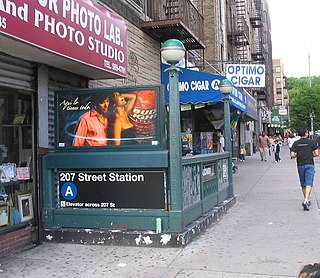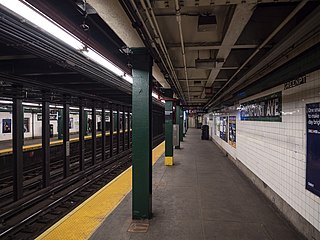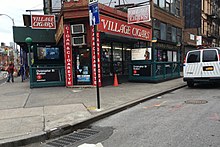
The 163rd Street–Amsterdam Avenue station is a local station on the IND Eighth Avenue Line of the New York City Subway, located in Washington Heights, Manhattan, at the intersection of Amsterdam and Saint Nicholas Avenues. It is served by the C train at all times except nights, when the A train takes over service.

Alamo, also known as the Astor Place Cube or simply The Cube, is an outdoor sculpture by Tony Rosenthal, located on Astor Place, in the East Village neighborhood of Manhattan in New York City. It is a black cube, 8 feet (2.4 m) long on each side, mounted on a corner. The cube is made of Cor-Ten steel and weighs about 1,800 pounds (820 kg). The faces of the cube are not flat but have various indentations, protrusions, and ledges. The sculpture's name, Alamo, is designated on a small plaque on the base and was selected by the artist's wife because its scale and mass reminded her of the Alamo Mission. It was fabricated by Lippincott, Inc.

The Inwood–207th Street station is the northern terminal station of the IND Eighth Avenue Line of the New York City Subway. Located at the intersection of 207th Street and Broadway in the Manhattan neighborhood of Inwood, near Inwood Hill Park, it is served by the A train at all times.

The 59th Street–Columbus Circle station is a New York City Subway station complex shared by the IRT Broadway–Seventh Avenue Line and the IND Eighth Avenue Line. It is located at Columbus Circle in Manhattan, where 59th Street, Broadway and Eighth Avenue intersect, and serves Central Park, the Upper West Side, Hell's Kitchen, and Midtown Manhattan. The station is served by the 1, A, and D trains at all times; the C train at all times except late nights; the B train during weekdays until 11:00 p.m.; and the 2 train during late nights.

The 155th Street station is a local station on the IND Eighth Avenue Line of the New York City Subway. Located under the intersection of 155th Street and St. Nicholas Avenue, at the border of the Harlem and Washington Heights neighborhoods of Manhattan, it is served by the C train at all times except nights, when the A train takes over service.

The 65th Street station is a local station on the IND Queens Boulevard Line of the New York City Subway, located at the intersection of 65th Street and Broadway in Queens. It is served by the M train on weekdays, the R train at all times except nights, and the E and F trains at night. The station opened on August 19, 1933, as part of the Independent Subway System's Queens Boulevard Line.

The 67th Avenue station is a local station on the IND Queens Boulevard Line of the New York City Subway. Located at the intersection of 67th Avenue and Queens Boulevard in Forest Hills, Queens, it is served by the M train on weekdays, the R train at all times except nights, and the E and F trains during late nights.

The 46th Street station is a local station on the IND Queens Boulevard Line of the New York City Subway. Located at the intersection of 46th Street and Broadway in Astoria, Queens, it is served by the M train on weekdays, the R train at all times except nights, and the E and F trains at night.

The Greenpoint Avenue station is a station on the IND Crosstown Line of the New York City Subway. Located at the intersection of Greenpoint and Manhattan Avenues in Greenpoint, Brooklyn, it is served by the G train at all times.

The Bedford–Nostrand Avenues station is a station on the IND Crosstown Line of the New York City Subway. Located at Lafayette Avenue between Bedford and Nostrand Avenues in Bedford–Stuyvesant, Brooklyn, it is served by the G train at all times.

Many New York City Subway stations are decorated with colorful ceramic plaques and tile mosaics. Of these, many take the form of signs, identifying the station's location. Much of this ceramic work was in place when the subway system originally opened on October 27, 1904. Newer work continues to be installed each year, much of it cheerful and fanciful.

Gem Spa was a newspaper stand and candy store located on the corner of St. Mark's Place and Second Avenue in the East Village neighborhood of Manhattan, New York City. It opened under another name in the 1920s, and was renamed in 1957. It was open 24 hours a day, and was known for being commonly considered to be the birthplace of the authentic New York City-style egg cream, which its awning described as "New York's Best."

Caffe Reggio is a New York City coffeehouse first opened in 1927 at 119 Macdougal Street in the heart of Manhattan's Greenwich Village.

75½ Bedford Street is a house located in the West Village neighborhood of New York City that is only 9 feet 6 inches wide. Built in 1873, it is often described as the narrowest house in New York. Its past tenants have included Edna St. Vincent Millay, author Ann McGovern, cartoonist William Steig and anthropologist Margaret Mead. It is sometimes referred to as the Millay House, indicated by a plaque on the outside of the house. The house is located in the Greenwich Village Historic District, but is not an individually designated New York City Landmark.

The Uncommons is a board game café in New York City established in 2013, located at 230 Thompson Street in Greenwich Village. It has claimed to be the first board game café in Manhattan, and the largest board game library on the East Coast.

Elizabeth H. Berger Plaza is a public park in the Financial District of Manhattan, New York City. formed by the triangular junction of Trinity Place, Greenwich Street and Edgar Street. It faces the Manhattan exit ramp from the Brooklyn–Battery Tunnel. Formerly known as the Edgar Street Greenstreet, this park honors civic advocate Elizabeth H. Berger (1960-2013). In her role as president of the Downtown Alliance, she advocated for the fusion of two traffic triangles at this location into an expanded park. The park is located on the site of a former neighborhood known as Little Syria, a bustling immigrant community displaced by the construction of the tunnel in 1953.

The New York City AIDS Memorial is a public memorial in Greenwich Village, Manhattan, New York City built "to honor New York City's 100,000+ men, women and children who have died from AIDS, and to commemorate and celebrate the efforts of the caregivers and activists." It is the first major space that is dedicated to the epidemic in New York City. The memorial was opened on World AIDS Day on December 1, 2016. The design was developed by the efforts of nearly 500 architects who came up with the idea of an 18-foot steel canopy as the gateway to the new St. Vincent's Hospital Park in Greenwich Village.
Harry & Ida's Meat and Supply Co. was a smokehouse and delicatessen located in Alphabet City, Manhattan, New York City that operated from 2015 to 2019.
The Tribeca Dog Run is a 4,000-square-foot (370 m2) public park located in the New York City borough of Manhattan. It is located on Warren Street between Greenwich Street and West Street in the Tribeca neighborhood.

The Central Park mandarin duck, also known as Mandarin Patinkin or the Hot Duck, is a male mandarin duck seen at the Pond in New York City's Central Park starting in late 2018. His colorful appearance, which contrasted with native waterfowl, combined with his presence far outside of the species' native range of East Asia, led to media attention from late 2018 through 2019. Though he has a band around its leg, his origin is undetermined. His last sighting was in March 2019. In 2021, entertainer Bette Midler published a children's book about him. In 2023, filmmaker Kevin Schreck released a short documentary about the bird, The Duck of New York. The film had its world premiere at the 2023 Coney Island Film Festival.



















